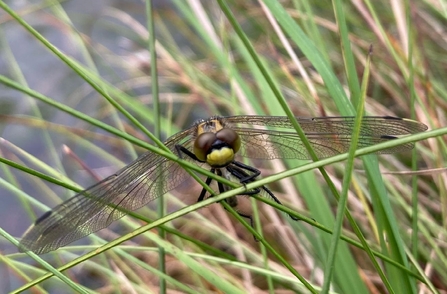
White-faced darter at Drumburgh Moss Nature Reserve © Cumbria Wildlife Trust

White-faced darter at Drumburgh Moss Nature Reserve © Cumbria Wildlife Trust
A rare dragonfly looks set to have a very successful breeding season at Drumburgh Moss Nature Reserve. At the start of our survey season, we found that 328 dragonflies had already emerged. That’s half of the total from the whole of last year’s season.
The white-faced darter, a small, dark dragonfly with red or yellow markings and a distinctive white face, is currently only found at a handful of sites around England. We've introduced it to Drumburgh Moss Nature Reserve over five years since 2019 in collaboration with the British Dragonfly Society.
Jack Dryden, Assistant Reserves Officer North for Cumbria Wildlife Trust said: “This is a fantastic result – 328 is a really encouraging number for the first day of our monitoring season. For comparison, it’s over half of last year’s total count of 627, which was done over seven weeks of monitoring. The year before that, in 2022, there were 124, so it looks like numbers will continue to rise, which is brilliant news.
“I wasn’t suspecting such high numbers, as the larvae usually have two-year life cycles, and two years ago the weather was quite bad during their emergence. This can injure a lot of vulnerable emerging dragonflies, reducing the number that then go on to reproduce. But this year’s numbers suggest that they are clearly more resilient than we give them credit for!”
We monitor the site alongside David Clarke, the British Dragonfly Society County Recorder for Cumbria, who has been a key figures in this project, and with the help of a team of volunteers. Jack said: “We do weekly surveys at Drumburgh Moss and fortnightly surveys at the donor site. It involves crawling around on our hands and knees collecting the empty skins of the aquatic larvae that have been left behind when the adult dragonflies emerge. This gives us the minimum number of dragonflies that have emerged from the pools. It’s impossible to find them all, so there are likely to be more than we actually count.
“It’s a great way for volunteers to get into wildlife monitoring, as long as you’re willing to get soggy knees! Once the skins are collected, David Clarke takes them away and painstakingly counts them all. Then we get a number for how many have emerged from each of the twelve pools that we monitor across both Drumburgh Moss and the donor site.”
“It’s a lot of effort for just one species of insect, but it actually brings together a lot of people, from experts to members of the public and partner organisations. We’re all working together to try and reverse the declining trend for wildlife in this country. These little victories all add up!"
David Clarke said: “It’s very pleasing that this attractive dragonfly has taken so readily to the homes we’ve provided for it on Cumbria Wildlife Trust’s nature reserves. Unlike many kinds of dragonfly, it’s very fussy about where it lives and doesn’t usually fly over long distances, which is why we’ve been giving it a helping hand to reach new sites.”
The goal is for the white-faced darter to be able to sustain itself at Drumburgh Moss, without bringing over eggs from the donor site, and the evidence so far is positive. Eggs and larvae were only introduced to two pools at Drumburgh Moss and they have now naturally spread to four others. We hope the white-faced darter’s horizons will broaden even further across the Solway Mosses. We're is working alongside the British Dragonfly Society, Natural England and the RSPB to achieve this aim.
The decline of white-faced darters in Britain is linked to the historic loss of the habitat they depend on - peatlands with deep bog-pools - through climate change and human activities. Drumburgh Moss Nature Reserve, a site of international importance, was chosen for white-faced darter introduction as it has over 150 hectares of restored peatbogs. This is the ideal breeding ground for this species, with quantities of floating Sphagnum moss, which the dragonflies need for laying their eggs.
In recent years, we've carried out extensive restoration works at the site, to repair damaged peatbogs by blocking ditches, reprofiling peat faces and removing trees and scrub. This has helped to raise the water level so that the bog vegetation can regrow. Repairing peatbogs not only helps the threatened species which rely on this habitat but enables the peatbogs to once again lock up carbon from the atmosphere. Healthy peatlands like these play a very important role in helping to tackle the climate crisis.
In a joint project with the British Dragonfly Society, we've also successfully reintroduced the white-faced darter at Foulshaw Moss Nature Reserve, following extensive restoration of this wetland habitat.